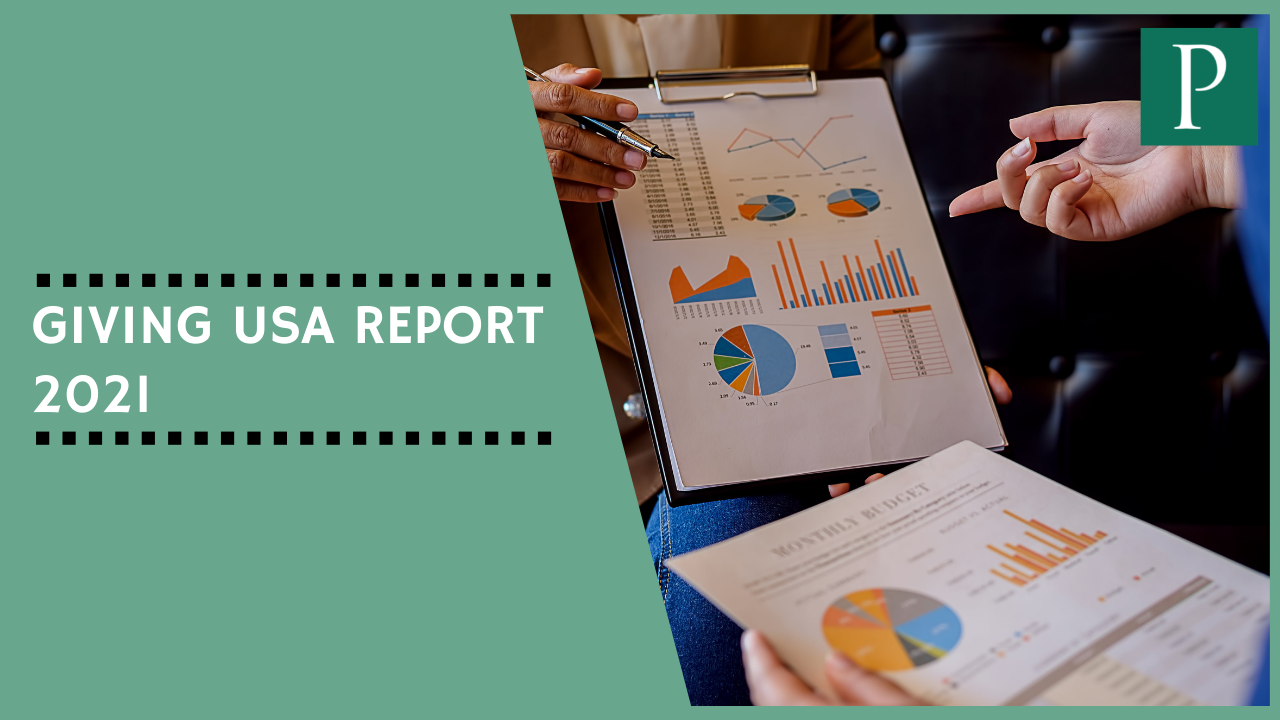Giving USA Report 2021

By Mary P. Walker, Petrus Blog Contributor & Local Charity Board Member
Latest Information on Giving Trends
Giving USA 2021: The Annual Report on Philanthropy for the Year 2020 was released in June. This report on the state of philanthropy is LONG and comprehensive, so I picked a few findings that would interest Petrus clients and blog readers. The opinions expressed below are my own. If you would like more detail, summary information is available for free here and you can purchase the full report here.
- 2020 marked an all-time high in philanthropic giving.
More money was given last year than in any previous year studied, and about 5% more than in 2019. There are probably a number of reasons for this: (1) households whose incomes were NOT greatly affected by the pandemic, such as retirees on fixed incomes or those who stayed employed, felt a greater internal motivation; (2) investment value and the stock market recovery was high, which affects the wealth of individuals and the funds available for foundations to give; (3) nonprofits successfully pivoted and continued their development efforts even though the pandemic affected in-person interaction.
- Religion giving was essentially flat in 2020.
I view this as a good news/bad news statistic. The bad news is that the giving in the religion sector only grew by 1%--not keeping up with inflation. BUT when you consider that many couldn’t attend church services for much of 2020 and therefore could not put money in the collection, things could be worse! The fact that this giving did not greatly decline is a tribute to the faithful and to churches/parishes that were prepared for ways to give beyond the pews, such as online gifts or mail-in donations. Also, I suspect than many of the faithful channeled their giving toward social service activities to help those most affected by the pandemic. As development professionals, we should be ENCOURAGED.
- Fewer donors are making gifts.
Although the overall amount of giving is up, the percentage of these gifts coming from individuals has been on a downward trend. In 1980, 84% of philanthropic giving came from individual gifts. Today, this is 68%. This concerns me. Fewer people giving is not good news even if more is being given overall. In the past, those who were younger or had less income were more likely than they are today to participate in philanthropy. This suggests an action plan to make sure we are engaging all our potential benefactors, regardless of their current capacity to give. The seeds for future large gifts are sown today.
- Foundation giving grew tremendously over the last year.
19% of total giving in 2020 came from foundations. This is the highest dollar amount recorded and represents a 17% increase over 2019. Foundation giving typically comes from investment income, and with a strong recovery, foundations had more to give. Yet, this increase was a bit of a surprise. Please note that about half of the foundation sector is “family” foundations. Often the grant-making process of family foundations is less structured than the larger foundations. This suggests that in addition to the formal grant application process, we need to engage foundations in the same way we would individuals who have the capacity to make gifts. That is, we need to move beyond the grant proposal and make connections with the decision makers. It also suggests a more “grassroots” identification of foundations, such as researching what family foundations are within your geography or working with your local community foundation.
- Bequest giving is on the rise.
Planned giving was about 9% of the total giving in 2020, and represented a 10% increase over 2019. Aging baby boomers are presiding over the greatest transfer of wealth in history. Any ministry that is not talking about planned giving internally and with their benefactors is missing an opportunity. Planned giving programs can and should be simple and ongoing. I’ll discuss this in a future blog post. BUT the takeaway now is to include planned giving in your development plans. The baby boomers are not getting any younger and there are fewer of them around every day!
- Online giving reached an all-time high.
13% of total gifts came from online giving. For many years, online giving was less than 10%. It took a jump in 2020, perhaps because people were unable to give in-person. This may indicate that we have reached a tipping point in the acceptance of online giving. Perhaps the challenges of 2020 provided an opportunity for those who have been hesitant to give online to try it out, and now they are comfortable. This means that your online giving site must be the best it can be: easy to use and donor-centered. Way too many online giving sites send donors away because there are too many steps, too much to type in, or are hard to understand. 2021 should be a time when we “clean up” and improve our online giving portals. In addition, all of our development materials should offer the online giving option.
2020—The Unprecedented Year
Is 2020 an “outlier” year in terms of generosity? Was 2020 a good year for your ministry, and how is 2021 looking? With 2021 over half over, it’s a good time to take stock in where you are in your development goals TODAY and see what needs to be adjusted, ramped up, or dropped to have a strong year-end finish!
READY TO BECOME A BETTER FUNDRAISER?
Sign up below to receive tools, ideas, and inspiration to take your development efforts to the next level.
We hate SPAM. We will never sell your information, for any reason.


